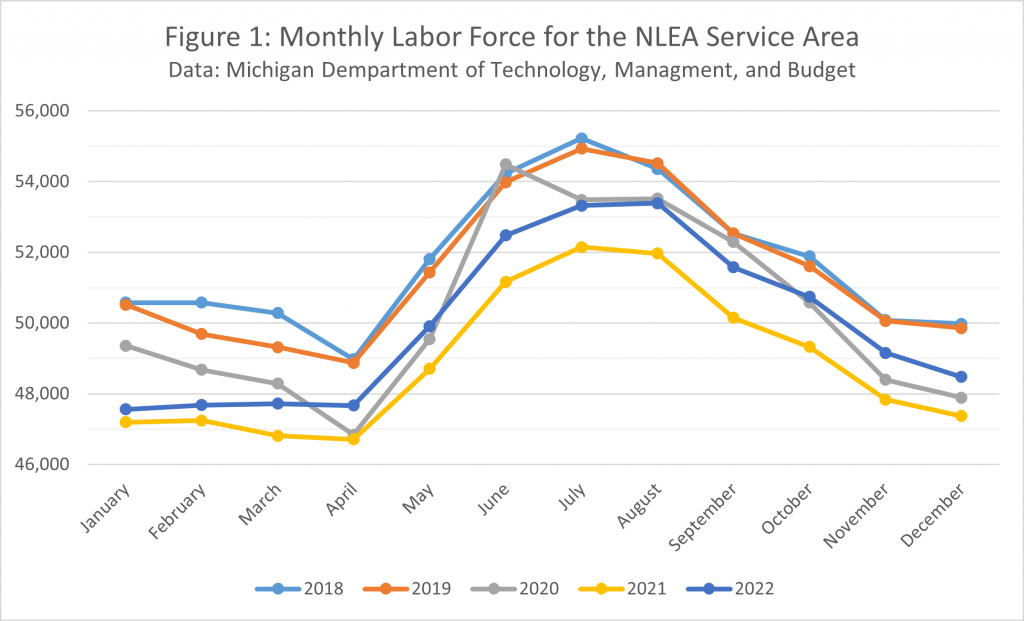This article examines the annual labor force cycle as thousands of workers enter the the labor force each summer.
By Sam Bailey, Strategic Initiatives Manager
It is May in Northern Michigan! College students and seasonal residents are returning, and local students are tantalizingly close to summer break. That means that our regional economy is about to kick into overdrive. Every year, youth employment plays a vital role in meeting demand, but regional trends show that the regional labor force is still below its pre-pandemic levels.
Seasonal Swing in Population
While everyone is personally familiar with the swell of people coming to Northern Michigan in the summer, Networks Northwest published a seasonal population study in the fall of 2022. Below, Table 1 shows the results of that study for the NLEA service area.
Table 1: Seasonal Population Estimates |
||||
|
|
Minimum Population |
Maximum Population |
Population Change |
Percent Change |
Antrim County |
30,860 – Mar |
59,352 – Jul |
28,492 |
92% |
Charlevoix County |
34,603 – Apr |
59,533 – Jul |
24,930 |
72% |
Emmet County |
43,666 – Feb |
89,628 – Jul |
45,961 |
105% |
|
*Data is from Networks Northwest’s 2022 Northwest Michigan Seasonal Population, Seasonal Workforce, and Short-Term Rental Study. **Data is not available for Cheboygan County. |
||||
According to these estimates, Antrim County’s population change is driven by almost 15,000 part-time residents and over 21,000 overnight visitors. Charlevoix County’s growth is driven by over 11,000 part-time residents and over 22,000 overnight visitors. Emmet County’s increase is driven by over 10,000 part-time residents and over 30,000 overnight visitors. These visitors fill our local hotels, restaurants, marinas, shops, and festivals.
Seasonal Swing in Labor Force
To meet the demand caused by the annual influx of consumers, the regional business community turns to youth workers. Young workers are integral to businesses that are seasonal in nature such as accommodation and food services; retail trade; and arts, entertainment, and recreation. Michigan’s Department of Technology, Management, and Budget recently released is 2023 job market forecast for Michigan teens ages 16-19. The release explains that the state’s population of teens ages 16 to 19 has been steadily declining over the past decade meaning that the number of available workers has declined too, a trend that is apparent in Northern Lower Michigan. The release goes on to state that; “there are just over 500,000 teens in this age group in Michigan, and roughly 235,000 (46.6 percent) plan on seeking or holding a job this summer.” Wayne Rourke, labor market information director of the Michigan Center for Data and Analytics asserts that “Teen participation in the state’s workforce is expected to be similar to pre-pandemic levels this summer.” If teen labor force participation is returning to pre-pandemic levels, does that mean our total labor force is doing the same?
Each summer, the NLEA service area adds thousands of workers to its labor force, driven primarily by high school and college students entering the workforce over break but also seasonal residents and adults who choose to enter the labor force during a time of increased demand. This seasonal cycle can be seen below in Figure 1.

Every year between January and July, Emmet County’s labor force increases by approximately 2,000 workers; Antrim County’s by approximately 1,500; Charlevoix County’s by approximately 1,800 individuals; and Cheboygan County’s by approximately 1,000. Notice that although the 2022 labor force (dark blue line) increased from the 2021 low (yellow line), it is still markedly smaller than prior to the pandemic. Despite a decrease in the month-to-month labor force, the magnitude of the seasonal swing remains. The new, smaller labor force can be partially attributed to trends seen across the country: older workers exiting the labor force earlier than expected, parents—disproportionately women—exiting the labor force due to childcare demands, and people reevaluating their professional lives.
Attracting and Retaining Talent
Much like the young workers looking forward to a break from school, we are all looking forward to summer. However, data indicates that the labor force constraints of the past few years will continue. Consumers should still expect longer wait times, restricted business hours, and other challenges. The region will still experience an influx of seasonal workers, predominantly high school and college students, but our total labor force is still below pre-pandemic levels. The NLEA is taking several steps to begin to address the challenge of a shrinking labor force. The 2023 Northern Lakes Economic Symposium and Showcase will focus on this issue, bringing in academics and professionals to discuss talent issues through the lenses of different business types, communities, and age groups. Additionally, the 2023 NLEA/DTE Energy Foundation Intern Project will focus on developing social media content to better market the region, its businesses, and its communities to working-age individuals around the country.







